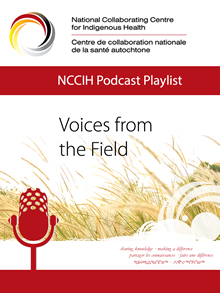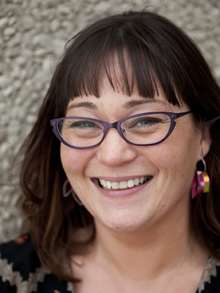 NCCAH Voices from the Field Podcasts
NCCAH Voices from the Field Podcasts
Voices from the Field
Welcome to Voices from the Field, a podcast series produced by the National Collaborating Centre for Aboriginal Health (NCCAH), which focuses on innovative research and community-based initiatives promoting the health and well-being of First Nation, Inuit and Métis peoples in Canada.
Episode 2: Birthing experiences of First Nations women from northern and remote communities
This episode provides an overview of a community-driven research project underway on the birthing experiences of First Nations women from Norway House Cree Nation in northern Manitoba. The project, spearheaded by Dr. Jaime Cidro of the University of Winnipeg, looks at some of the multiple social, emotional, financial, and cultural burdens faced by First Nations women in Norway House Cree Nation when they are required to leave their communities to give birth. In this podcast you will hear how this project came about, what research questions it will address, and why bringing maternity programs and birthing back to the community should be a priority.
Listen on SoundCloud
 Dr. Jaime Cidro, Associate Professor,
Dr. Jaime Cidro, Associate Professor,
Department of Anthropology,
University of Winnipeg
Bio
Dr. Jaime Cidro is an Associate Professor in the Department of Anthropology at the University of Winnipeg. She works in areas of Indigenous social determinants of health, including traditional food. She also works in areas of maternal child health and recently began work on Indigenous doulas for First Nations women who travel for birth. For more information on the project, please email Dr. Jaime Cidro.
Transcript
The research that we’ve done is 360-degree community-based perspectives on returning birthing to a remote northern First Nations community. It’s a northern Manitoban First Nations community, specifically, Norway House Cree Nation. I had been doing some research up there already and they had been working towards a maternity care program, or developing that, or returning those types of services to the community. The health director at the time asked me to develop some information that they felt they required to move that piece forward.
I think the one thing that has been important for this project is that it has been, right from the beginning, highly collaborative. We had the First Nations Health and Social Secretariat of Manitoba involved, they were formally out of the Assembly of Manitoba Chiefs, the midwifery clinic, the Norway House Health Division, and the University of Manitoba Remote Residency Program. There are all these kinds of partners involved and one of the things we really want to focus on was around ownership of data and making sure that because the community had asked for this project, that we wanted to make sure that they had access in a way that was appropriate for them and appropriate for us. So this kind of negotiation process was something that we wanted to start off so the project started off in a good way, since everyone knew what was going to happen to the data. The data was there for the community to have access to. It took quite a bit of time. We have a fairly comprehensive data management agreement, we developed it. The result of that is that we have a highly involved community Advisory Council to guide the project throughout all the stages.
Because I knew that women were having to leave the community to birth outside of the community, I really felt it was fairly shocking and could potentially have lots of negative repercussions for women. I am a mother myself and I know when you have a baby it’s not just a physiological experience, you know there are lots of emotional pieces attached to that and so the idea of having to leave the comfort of my home to birth in a place alone is something that I thought would be very challenging for people. And so I was asked to do this and as someone who has given birth myself, I really felt an obligation to help provide the information that the community was looking for.
The project was actually quite large in scope. We wanted to look at a number of pieces. The first piece, and actually the piece I was most interested in, is the women’s experiences. What is it like to leave the community to birth in Winnipeg or Thompson? And we know that in the last number of years there have been women who have birthed in the community. So there are number of different kinds of birthing situations. We wanted to look at all of those experiences. So the emotional experiences is something that we looked at, the financial issues, also a whole … range of care issues. The other pieces that we looked at were the perspectives of the primary healthcare providers – issues of risk, issues of resources. And the third thing we looked at was what the feasibility would be of returning birthing to a remote community like Norway House. So this is the piece that is underway right now. We are doing a retrospective chart review to really ascertain the number of women who would be characterized as low risk. Those are the kind of three main pieces, and in addition to that we decided to do a community-wide survey, so not just looking at perspectives of women but of both women and men in the community. We had a high participation rate for that as well, so that ended up being a fourth piece. We feel like we will have a fairly comprehensive view of what people in the community, including the health care providers, really think about the possibilities of returning maternity services and what some of the challenges and opportunities are there.
One of the things that happens, I think in many communities, [is] there’s fairly elaborate services that take place in the community, a lot of effort goes in to remembering and acknowledging the life of people who pass on. But at the beginning stages, that kind of level of celebration and acknowledgement seems to be missing when women deliver their babies outside of the community. So that kind of connection to home and that identity piece is somewhat disrupted, right? We heard some interesting stories from women who were born in the community and who had children who were born in the community and how they connected to the actual kind of land-base. I think there is this level of disruption [that] takes place when women are required to leave the community to give birth.
Download the transcript